Books
Books
in random order

Read Me: Selected Works
Read Me gathers the tools necessary to make sense of contemporary problems so ubiquitous they seem too big to name. Spanning a multiplicity of genres, media, and tonal registers, this book surveys Holly Melgard’s formally experimental poetic works produced between 2008 and 2023, including sound poems, essays on poetics, and books that exploit print on demand to, for example, counterfeit money. In often wildly comic turns of thought, Melgard’s work cleaves personal agency from automated defaults by mapping trauma and technocracy from the inside out.
From critical talks to fictional monologues, the poet translates into language the unremarkable torments of neoliberalization in the digital age.
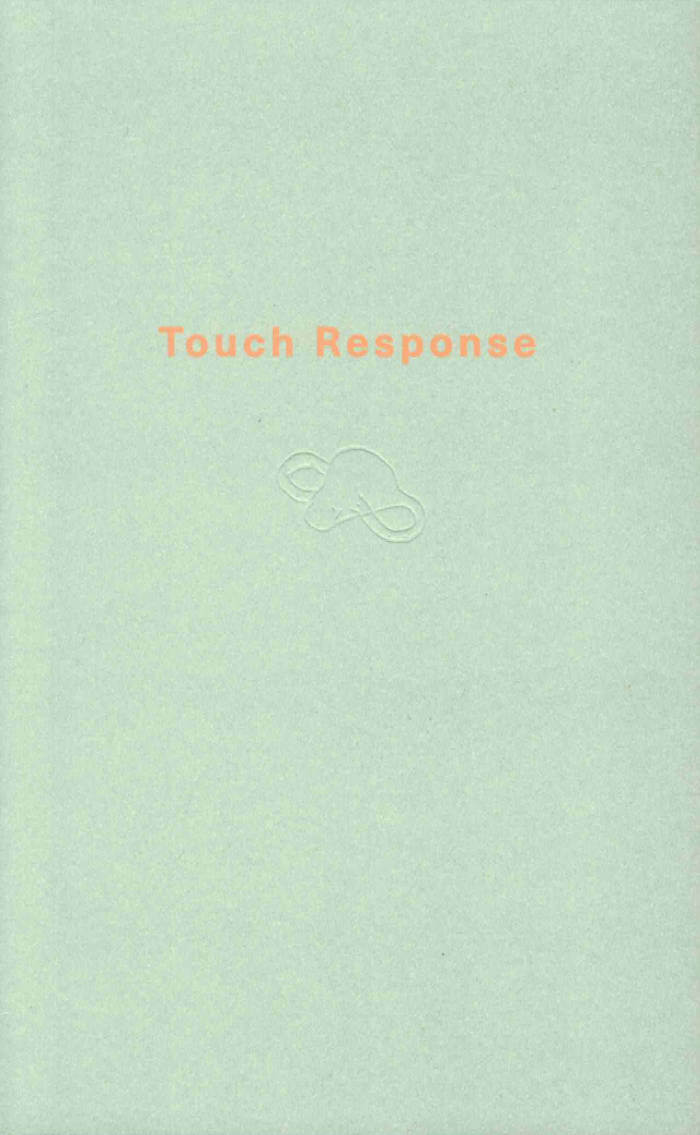
Touch Response
Touch Response is about lacking language and how to (not) interpret images. This is a book on vulnerability, as a description, prescription or side effect. It is made in a difficult period of fatigue and pain, mainly in the sofa in my living room, as a dialogue with myself and other invisible forces.
Drawings by Lore Smolders - visual artist
Interview with Birds WG - healer, writer, performance artist
Text editing by Isolde Vanhee and Joan Somers Donnelly

Evolution
"In Eileen Myles's newest book of poetry, Evolution, we encounter an arrival, a voice always becoming, unpinnable and queer. Myles's new poems are transformations, and perhaps a culmination of the poet's previous inquiries into love, gender, poetry, America, and its politics . . . The form of Myles's work rivals its subject matter in intimacy. The lines in Evolution are physical, a body unleashed but not yet comfortable and not without fear. The short lines rush down the page, movement as touch, touch as freedom." — Natalie Diaz, New York Times Book Review

Choquer le monde à mort – Elles sont de sortie – Pascal Doury – Bruno Richard
Bruno Richard, Pascal Doury and 1 more
"Elles sont de sortie" is the title of a periodic publication launched in 1977 by Pascal Doury and Bruno Richard. The plural and feminine form of the enigmatic phrase "elles sont de sortie," chosen almost by chance, announces a protean work and often collective experience. From its origins to the most recent iterations, including Doury's more confidential individual trajectory after "Elles sont de sortie," Choquer le Monde à Mort traces five decades of a corpus of nearly three hundred publications. It addresses some of the most emblematic editorial works, as well as others that remain unpublished, alongside ambitious and sometimes scandalous exhibitions, few of which are documented.
This work is the result of several years of research, enriched by numerous firsthand interviews, and unfolds in three parts: a chronology and analysis of a singular and marginal artistic history, works and iconographic documents, and an anthology bibliography. Together, these elements reveal the complexity of an editorial object with porous boundaries, both in its forms and its contents, oscillating between graphzine, artist book, poetry collection, and personal journal. Its ramifications, status, and legacy retrospectively reveal the importance of a discreet yet seminal work.
Thus, "Elles Sont de Sortie" also serves as an opportunity to revisit the paths of two aesthetic and provocative artists, deeply devoted to their art and true free spirits in an art world often too narrow for them. It immerses us in a plethora of works that are intimate and raw, as well as subtle and refined, all in service of a project that, in Doury's words, aims to "shock the world to death."
Edited by Tiphanie Blanc, Jonas Delaborde, Anna Lejemmetel.
Contribution by Anna Lejemmetel.

Mycoscores / Choreospores
Mycoscores / Choreospores is a set of artistic scores for exploring the connections between fungal and human ways of being, particularly through movement and dance. The scores propose starting points for dancing, weaving together social connections, composing and exploring performativity.
The publication consists of 31 cards, each presenting a single score, a booklet with a text entitled Fungi Feel, the introduction, instructions, a glossary and additional short text entries accompanying the scores.
Scores, writing and concept by Maija Hirvanen
Graphic design: Arja Karhumaa
Publisher: Friends of Physical Contemporary Art, in the frame of Performing Portals project. In collaboration with DAS Research/DAS Publishing, Academy of Theatre and Dance, Amsterdam. Published Jan. 2024
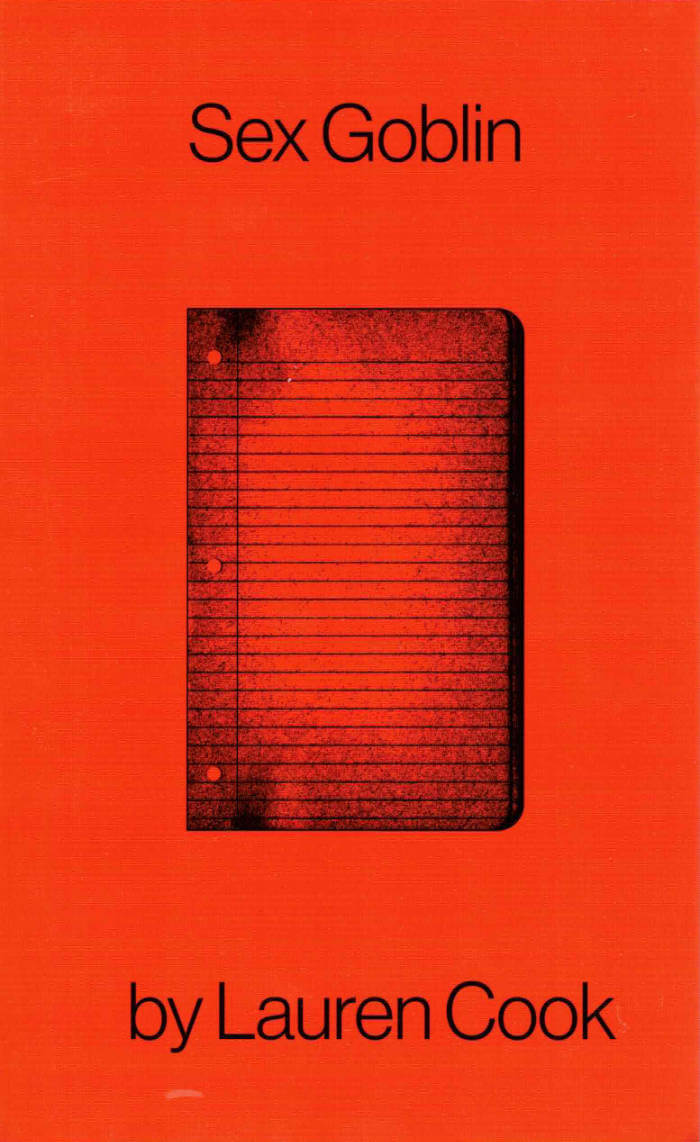
Sex Goblin
A weird, wild ride across non-narrative vignettes and dryly funny aphorisms exploring the shared intensity of violence and the erotic.
As if hauled up squirming from the bowels of the internet, Sex Goblin metabolizes sex writing, popular culture, and autofiction to present the real and the imagined as equally surreal possibilities. In the narrator’s childlike voice, all things become both mundane and strange—a child and their dog fused after a car accident, moments of tenderness amidst frat hazing, witches, and hiking accidents. At turns charming and bizarre, Cook’s work channels sexual violence through the lens of the absurd to alchemize shame and abuse into something that registers differently than trauma. Sex Goblin is a barely factual but deeply felt field guide to relationships and relatability.
Lauren Cook is a transsexual naturalist and the author of I Love Shopping (Glo Worm Press, 2019). He is from upstate New York.

Voices of the Nakba: A Living History of Palestine
First-generation Palestinian refugees recall life before and after the Nakba.
During the 1948 war more than 750,000 Palestinian Arabs fled or were violently expelled from their homes by Zionist militias. The legacy of the Nakba - which translates to 'disaster' or 'catastrophe' - lays bare the violence of the ongoing Palestinian plight.
Voices of the Nakba collects the stories of first-generation Palestinian refugees in Lebanon, documenting a watershed moment in the history of the modern Middle East through the voices of the people who lived through it.
The interviews, with commentary from leading scholars of Palestine and the Middle East, offer a vivid journey into the history, politics and culture of Palestine, defining Palestinian popular memory on its own terms in all its plurality and complexity.
Afterword by Rosemary Sayigh. Winner of an English PEN Award 2021.

Métaphoriques Cannibales
Métaphoriques Cannibales est un recueil transdisciplinaire, où le cannibalisme est pris comme métaphore, comme un concept ouvert aux analogies, comme anthropopoiésis et boîte noire, et comme fait social total.
Peuplent cet endroit des individus qui s’abreuvent de symboles, d’imaginaires, d’occulte, d’intime et ne craignent pas d’en recracher des images et idées d’une extrême violence, tout en constituant paradoxalement l’univers de leur production comme “safe space”.
Le cannibale est une spécialité belge, composée d’un toast recouvert de filet américain (une variante belge du steak tartare).
Transgressif et provocant, c’est ici un paroxysme de l’altérité et fantasme de l’Autre, qui permet par reflet de nous contempler nous-même.
La vie n’a de saveur que pour devenir viande.
La transgression, c’est aussi aller plus loin. Oser aller plus loin. Plus loin que les normes communément admises qui sont toutes relatives et violentes.
SUBSTANCE MOLLE ET SANGUINE
Nous cherchons des outils spéculatifs pour pænser notre monde.STIMULI VISUELS HOMOGÉNÉISÉS PAR LE ROUGE
C’est d’un brouillard polysémique empli de chimères, d’un tabou lardé de malaise et d’angoisse, bien au chaud dans un ventre plein de plasma, que ɴon-ᴀ émet ce recueil transdisciplinaire.
Dans la large brèche que nous propose l’ouverture de notre thématique, s’engouffre une multitude d’approches : de la chansonnette, au récit spéculatif, de la définition critique, à la BD vorarephile, du reportage photo, à la poésie expérimentale, de la théorie d’écologie spéculatif, à la performance eroticocculte.
Explorons les obscures profondeurs de nos éthiques pour y trouver les fondations de nos ontologies... se mordre d’une balle dans le pied.
Contributeur·rice·x·s
aariel136, Maurane-Amel Arbouz, Nina Bigot,Mathilde Block, Juliano Caldeira, Rémi Calmont, Rouge Cendre, Chloé Clemen, Sam Ectoplasm, Robin Faymonville, Gabriel René Franjou, Tristan Gac, Léo Gillet, Charlotte Guerlus, Théophile Gürtin, KarenDK, Olga Mathey, Louise Mervelet, Jean-Baptiste Molina, Hélène Alix Mourrier, Carole Mousset, Lucy Ozon, Angel Raymond, Andres Komatsu & Camila Roriz, Paradoc sale, Manon Schaefle, Yan Tomaszewski, Tom Valckenaere, Chloé Viton, xX-Sukuba-Xx, Zelig, Janna Zhiri

the she
‘the she’ compares texts by Virginia Woolf with their French translation, reproducing parts of the novelles ‘The String Quartet' & ‘Blue and Green’ and the novel ‘The Years’. Of the novellas, she kept only the articles the in English and le, la, les in French, exactly as they appear in the editions. Of the novel, only the pronouns she in English and elle in French remain.
The publication includes identical two booklets, one bound and one unbound, both uncut, referring to old books which were often sold bound but uncut.
Offset printing. Printed by Cultura, Wetteren
Edition of 123 numbered copies
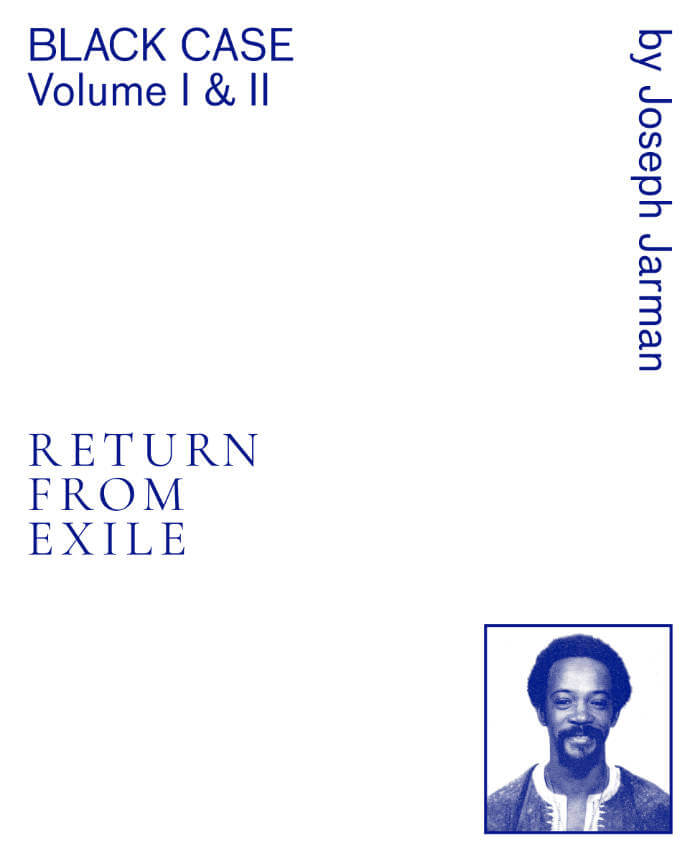
Black Case Volume I and II – Return From Exile
The republication in print form of the poems of Art Ensemble of Chicago's founding member breathes new life into a forgotten document of the Black Arts Movement.
In 1977, Art Ensemble of Chicago Publishing Co. published Jarman's Black Case Volume I and II: Return From Exile, a collection of writing conceived across America and Europe between 1960 and 1975. Comprised largely of Jarman's flowing, fiery free verse—influenced by Amus Mor, Henry Dumas, Thulani Davis, and Amiri Baraka—the book also features a manifesto for “GREAT BLACK MUSIC,” notated songs, concert program notes, Jarman's photos, and impressions of a play by Muhal Richard Abrams, the founder of the Association for the Advancement of Creative Musicians of which Jarman was also an original member.
Jarman writes poetry of personal revolutionary intent, aimed at routing his audience's consciousness towards growth and communication. He speaks with compassionate urgency of the struggles of growing up on Chicago's South Side, of racist police brutality and profound urban alienation, and of the responsibility he feels as a creative artist to nurture beauty and community through the heliocentric music that he considers the healing force of the universe. A practicing Buddhist and proponent of Aikido since a 1958 awakening saved him from the traumatic mental isolation of his time dropped by the US army into southeast Asia, Jarman sings praise for the self-awareness realization possible through the martial arts.
With cosmic breath as its leitmotif, his poetry both encourages and embodies a complete relinquishing of ego. While some of the poems contained within Black Case have already been immortalized via performances on classic records by Jarman and Art Ensemble of Chicago, its republication in print form breathes new life into a forgotten document of the Black Arts Movement.
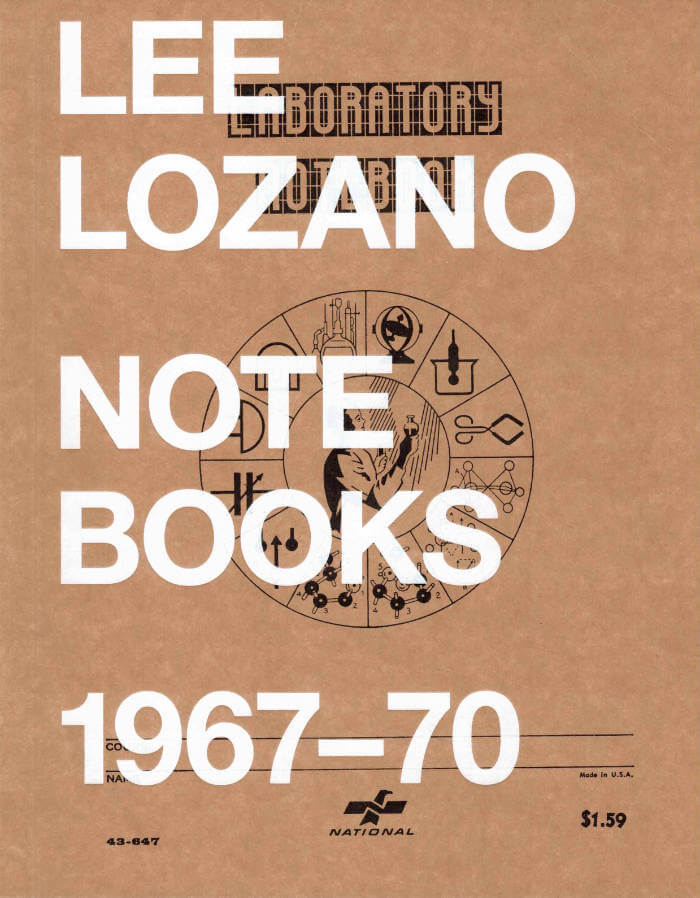
Notebooks 1967-70
This publication is a compilation of Lee Lozano’s notebooks from 1967 to 1970. The three notebooks included here contain her seminal “Language Pieces” and drawings for her paintings, including 12 studies for her 11-panel masterpiece, “Wave Series.”
Lee Lozano (1930-1999) was an enigmatic artist making a diverse body of drawings, paintings, and conceptual works. While prolific, her production was limited to her time in New York from the early 1960s to the early 1970s. She was very actively engaged with other artists in New York until she decided to leave the art world in 1972. Until recently, much of her work has been difficult for the public to access. From the time of her boycott of the art world until her death, Lozano was an artist working conceptually even though she did not participate actively in the commercial art world for the last three decades of her life.
The pages of the notebooks contain notes and sketches related to her abstract paintings and also contain her texts, which were known as “Language Pieces.” The artist’s work in the books reveal her desire to live and create art within a structured system. Lozano considered the individual pages of her notebooks to be drawings, and they were sometimes separated and exhibited. Twenty-five years ago, the notebooks were photocopied and it is that record which serves as the basis for this book.
Notebooks 1967-70 was first published by Primary Information in 2010. This is the second printing.
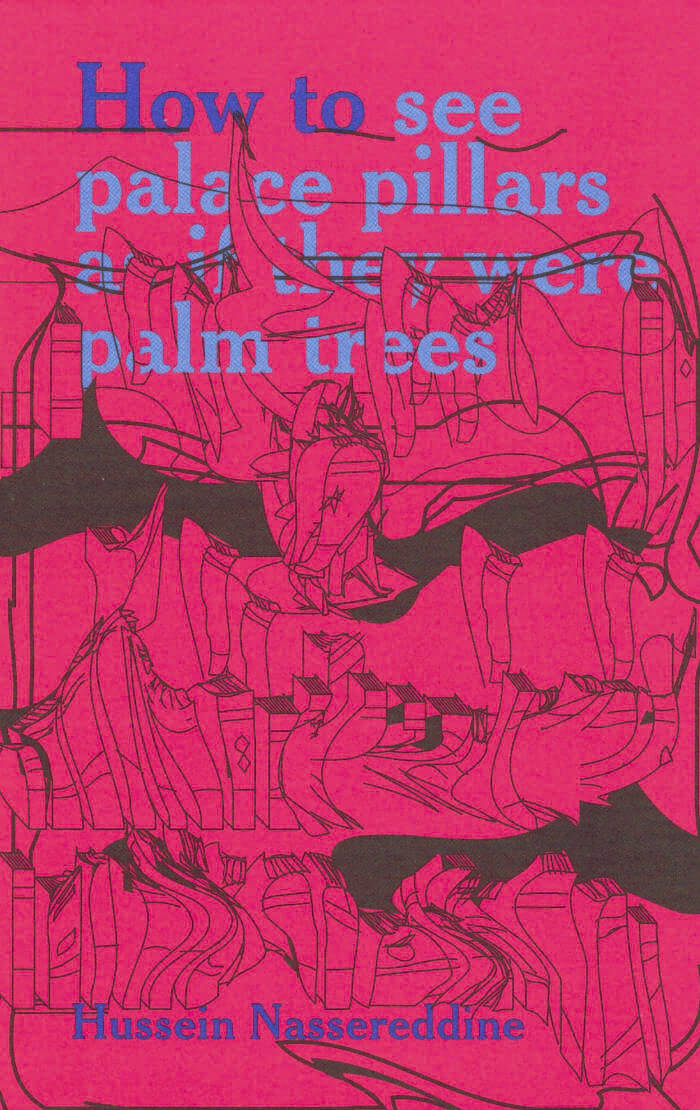
How to see palace pillars as if they were palm trees
For so it happens that when the poets speak, objects appear closer to their own shadows. The poet's mouth fills up with horses and marble, and his verses start to shine like rivers. These rivers then turn back to flow through the very palace he is depicting. The poet's own words begin to weigh down on him, as though he were holding up a palace with his palms. Then he travels, and the palace is obliterated. Countries and nations change, and naught remains but what the poets had seen. Of what the poets had seen, naught remains but its image in anthologies. And when the libraries have been flooded or burned to the ground, nothing but the commentaries on those anthologies are left, and all that one finds in these commentaries is that which was appropriated and wrought a thousand times over.
Hussein Nassereddine is a multidisciplinary artist. His work in installation, writing, video and performance originates from a practice around language that builds fragile monuments - some verbal, some sonic, some tactile - rooted in collective histories and resources of poetry, ruins, construction and image-making.
Translated from Arabic by Ben Koerber.

Songhai!
Askia Touré was there at the birth of the Black Arts Movement. He was there at the birth of Black Power. In the era of decolonisation, Touré’s visionary poems and essays spoke powerfully to the Tricontinental struggle against the forces of colonialism and white supremacy in Latin America, Asia and Africa. They continue to speak to this struggle today. This 50th anniversary edition of Touré’s visionary 1972 book Songhai! is his first UK book publication and provides a powerful guide to the states and stages of Black radical politics not only during and up to 1972, but into our uncertain future.
Reprinted with a new foreword and original preface by Askia Touré, original introduction by John Oliver Killens, and a new introduction by David Grundy. Illustrations by Abdul Rahman.
Askia Touré is one of the pioneers of the Black Arts / Black Aesthetics movement and the Africana Studies movement. Ishmael Reed has called Touré “the unsung poet laureate of cosmopolitan Black Nationalism.” His poetry has been published across the United States and internationally, including in Paris, Rome, India, and The People’s Republic of China. His books include From the Pyramids to the Projects, winner of the 1989 American Book Award for Literature; African Affirmations: Songs for Patriots: New Poems, 1994 to 2004, and Mother Earth Responds. In 1996, he was awarded the prestigious Gwendolyn Brooks Lifetime Achievement award from the Gwendolyn Brooks Institute in Chicago. Now based in Massachusetts, since August 2019, Mr. Touré has been reading with the Makanda Orchestra, beginning with a celebration of the South African musician Ndikho Xaba.

The Swarm
A shape-shifting, metaphysical thriller where sensorial, sexual, and revolutionary impulses are aligned for the purpose for anarcho-transcendent-communal escape, The Swarm circles around a sundry of anomalous and dead beings who plot their way out of Hungarian fascist rule in the thermal baths of Budapest.
Based in Berlin, Dalia Neis is a writer, filmmaker, and lyricist and vocalist for Dali Muru & The Polyphonic Swarm. Previous publications include Zephyrian Spools: An Essay, a Wind (Knives, Forks & Spoons), and Hercules Road (MA Bibliothèque).
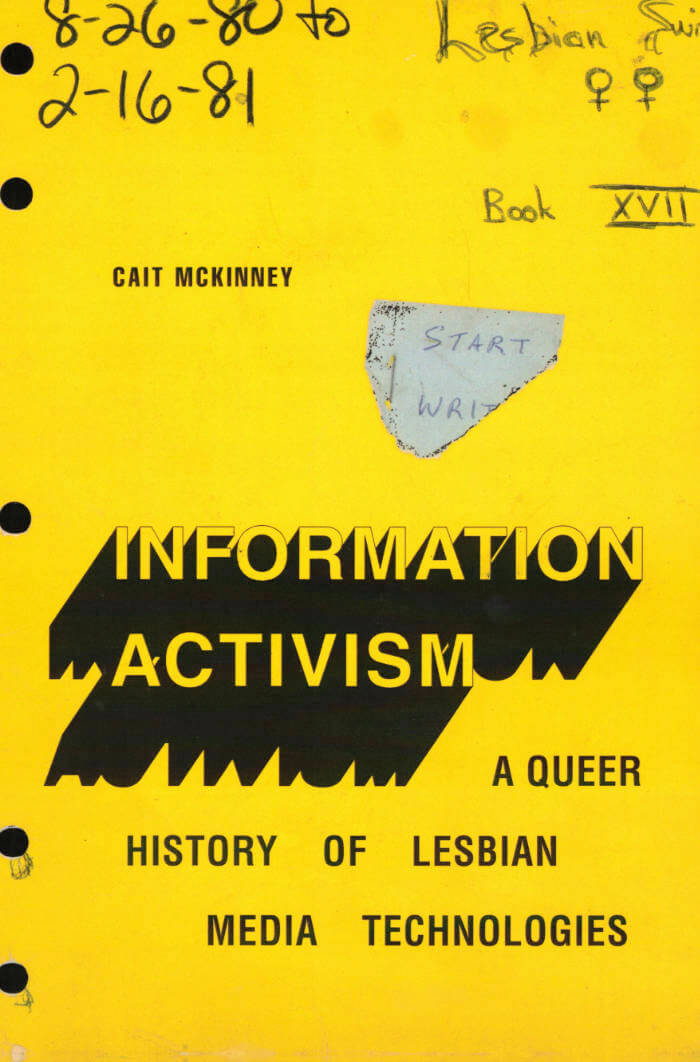
Information Activism: A Queer History of Lesbian Media Technologies
Cait McKinney traces how lesbian feminist activists in the United States and Canada between the 1970s and the present developed communication networks, databases, and digital archives to use as a foundation for their feminist, antiracist, and trans-inclusive work.
For decades, lesbian feminists across the United States and Canada have created information to build movements and survive in a world that doesn't want them.
In Information Activism Cait McKinney traces how these women developed communication networks, databases, and digital archives that formed the foundation for their work. Often learning on the fly and using everything from index cards to computers, these activists brought people and their visions of justice together to organize, store, and provide access to information.
Focusing on the transition from paper to digital-based archival techniques from the 1970s to the present, McKinney shows how media technologies animate the collective and unspectacular labor that sustains social movements, including their antiracist and trans-inclusive endeavors. By bringing sexuality studies to bear on media history, McKinney demonstrates how groups with precarious access to control over information create their own innovative and resourceful techniques for generating and sharing knowledge.
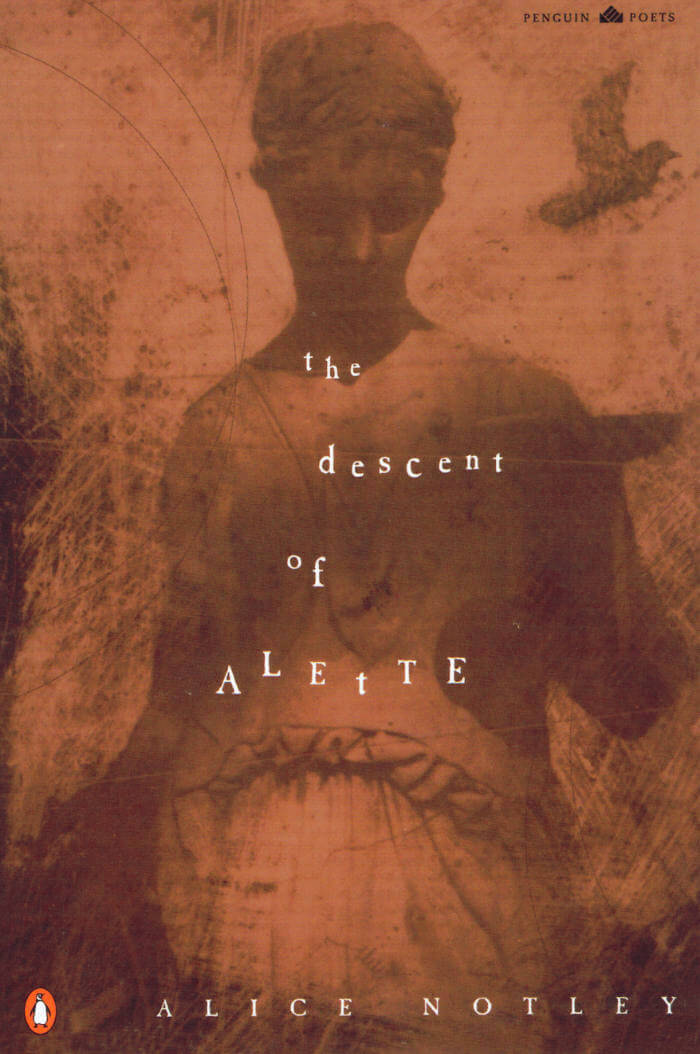
The Descent of Alette
The Decent Of Alette is a rich odyssey of transformation in the tradition of The Inferno. Alice Notley presents a feminist epic: a bold journey into the deeper realms. Alette, the narrator, finds herself underground, deep beneath the city, where spirits and people ride endlessly on subways, not allowed to live in the world above. Traveling deeper and deeper, she is on a journey of continual transformation, encountering a series of figures and undergoing fragmentations and metamorphoses as she seeks to confront the Tyrant and heal the world. Using a new measure, with rhythmic units indicated by quotations marks, Notley has created a spoken text, a rich and mesmerizing work of imagination, mystery, and power.
Alice Notley is a poet whose twenty previous titles include The Descent of Alette, Beginning with a Stain, Homer's Art, and Selected Poems. She wrote the introduction for her late first husband Ted Berrigan's Selected Poems. She lives in Paris.
Published 1996.
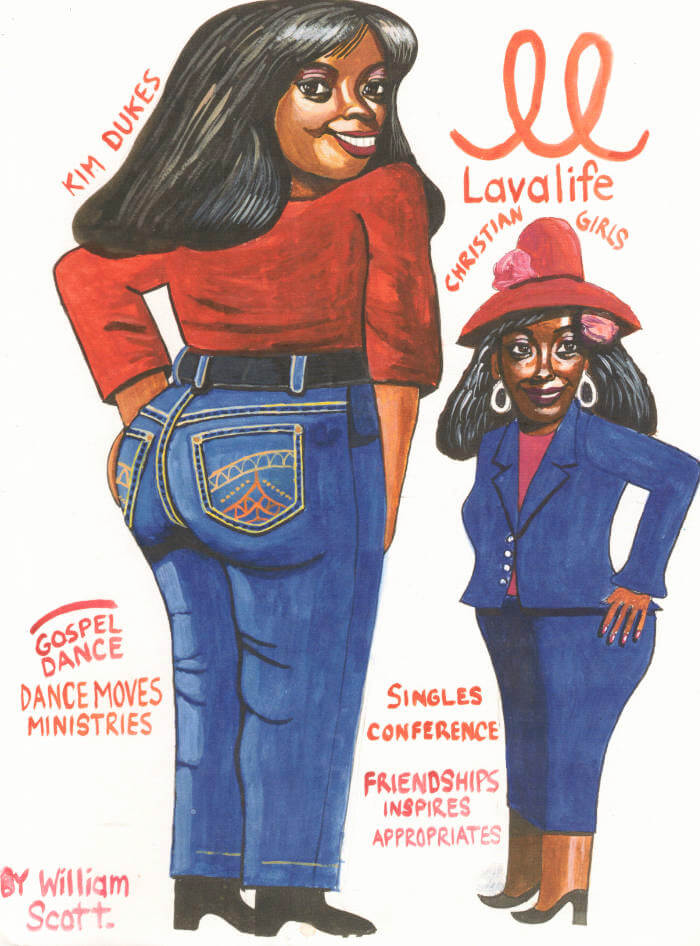
William Scott
Covering the past thirty years of William Scott's practice, this monograph offers the largest comprehensive selection of paintings, drawings, masks and architectural models, as well as an unique insight on his creative and transformative approach.
Published on the occasion of Malmö Konsthall William Scott's exhibition at Mälmo Konsthall en 2022.
William Scott (born 1962 in San Francisco) has developed his own artistic practice while working at Creative Growth, an art center in Oakland where people with development disabilities are given the opportunity to work and advance creatively as artists. Combining image and text, his colourful paintings tie in stylistically with current popular culture. Scott's vividly graphic and highly detailed paintings, drawings, and sculptures explore the intersections of community, cultural memory, faith, and science fiction. "Rebirth" is a constant subject for the artist, who reimagines the social topography of his native San Francisco as well as new, interstellar organizations. His portraits depict family members and neighbors, and celebrate Black actors, musicians, and civil rights leaders. For Scott, painting is a transformative as well as a documentary tool; a way to re-craft his personal narrative and even undertake extraordinary acts.
Edited by Nicola Wright
Texts by Carson Cole Arthur, Nana Biamah-Ofosu, Helen Delaney, Tom di Maria, Simona Dumitriu, Nathan Hamelberg, Kathleen Henderson, Matthew Higgs, William Scott, Nicola Wright

Writing Wounds to Heal

Jupiter: Andreas Sell ‘Life Performance’
Jupiter is the monograph of the artist Andreas Sell by the curator Joel Mu and the outcome of their collaboration. It includes a selection of Andreas’ work of the last fifteen years, an essay in five parts by Joel and a poem by Alice Heyward. Andreas’ work often coincides with his life story, composing both a material and immaterial narration. Joel shares biographical and autobiographical stories in his writing about Andreas’ work. The narratives intertwine.
Personal experiences, memories and relationships take shape with matter, images and words trying to make sense of the world—its social conditions and politics, other people and life itself.
Jupiter is about Andreas Sell’s ‘Life Performance’ as the title of the book suggests; it explores life performance from the constant position of a foreigner, from a viewpoint on the side. Andreas and Joel reflect on identities and challenge categorization; they seek for a more inclusive sense of belonging and defend the multiplicity of oneness. Jupiter also defies categorization; it is a monograph, but also a biography, an autobiography, a catalogue, an artist book, a diary, a collective work on one person’s work. — Text by Galini Noti

Suckcess Magazine 1 — Winter 2021-22
Drama, careers, sabotage, compromises... The first issue of Suckcess Magazine begins with a selection of poems by the flamboyant Rene Ricard, edited with the help of Editions Lutanie, and continues with contributions from Miriam Laura Leonardi, Fabienne Audéoud, Camille Aleña, Gabi Losoncy, David Lieske, Sylvie Fanchon, Won Jin Choi, Estelle Hoy, and Bunny Rogers. Cartoons and tennis players are also on the program.

Tender
The third and final installment of Ariana Harwicz's Involuntary Trilogy finds us on familiar, disquieting ground. Under the spell of a mother's madness, the French countryside transforms into a dreamscape of interconnected imagery: animals, desire, the functions of the body. Most troublingly: the comfort of a teenage son. Scorning the bourgeois mores and conventionality of their small town, she withdraws him from school and the two embark on ever more antisocial and dangerous behavior. Harwicz is at her best here, building an interior world so robust, and so grotesque, that it eclipses our shared reality. Savage, and savagely funny, she leaves us singed, if not scorched.
Compared to Nathalie Sarraute and Virginia Woolf, Ariana Harwicz is one of the most radical figures in contemporary Argentinian literature. Her prose is characterised by its violence, eroticism, irony and criticism of the clichés surrounding the notions of the family and conventional relationships. Born in Buenos Aires in 1977, Harwicz studied screenwriting and drama in Argentina, and earned a degree in Performing Arts from the University of Paris VII as well as a Master's in comparative literature from the Sorbonne. She has taught screenwriting and written plays, which have been staged in Buenos Aires. Feebleminded (which has also been adapted for the stage in Argentina and Spain) is her second novel and a sequel in an 'involuntary' trilogy, preceded by Die, My Love (Charco Press, 2017) and followed by Precocious. Her fourth novel, Degenerate comes out in June 2019. Die, My Love was longlisted for the Man Booker International Prize (2018) and shortlisted for the Republic of Consciousness Prize (2018). It has been translated into more than ten languages.
Translated by Carolina Orloff and Annie McDermott.
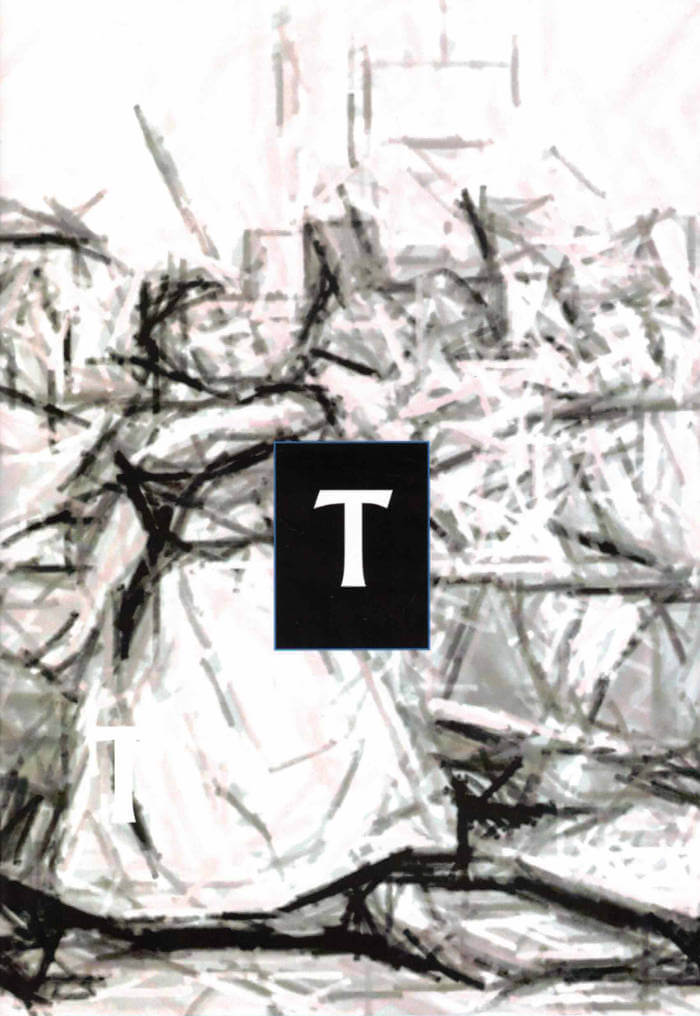
T (poem)
T is a long poem in multiple parts and its author's second book. “The two genders are YES and NO, so you stutter or else shut up forever”.
From the Afterword: "Between 2017-2018 I was involved in a trial with a group of TERFs after a scuffle emerged during a counter protest against a ‘debate’ about sex-based rights in light of proposed reforms to the Gender Recognition Act which would have made trans people’s lives marginally easier. Luckily I wasn’t actually in the dock, but I appeared to give evidence, and for everyone involved it was a humiliating ordeal as we were doxxed, harrassed online and in real life, while the relentless media campaign which ensued took a toll on the entire trans community. The caricaturesque reduction of a complex interrelation of political positions, epistemologies, traumas and personal grievances into two ‘sides’ ultimately worked to further the persecution of trans people, but nevertheless highlighted a social logic on whose terms the so called debate was forced to appear: sex was pitted against gender (or more revealingly ‘gender identity’), objective biology against subjective ‘self-identification’, nature against culture, or perhaps, first nature against second nature."
What does a poet say (what does anyone say), when placed on the stand, how answer the binary logics forced like a cage in the legally-grounded violence which splittingly interrogates solidarity, the splitting invocation of law? In answer, T spreads across the page as if desperately finding a form for speech acts forced into a garrotted tick-box, a witness stand, video evidence, Nature’s originary disguise as history or vice versa, wrapped inside ‘common sense’ as a pronominal shroud, in the policing of body, speech, and every fungible fibre of being. The author writes: “I want the whole text to be a kind of horrific inorganic body with awkward parts, both to replay at the level of form some of the critiques of organicist thinking with reference to nature that the poem tries to articulate, and also, more glibly, to be somewhat like a trans body, awkwardly fitting together with some parts undercutting others”. An extended enquiry into Materialism and its material (fleshed) stakes, driven through the heart and to the heart of things, T sees lyric poem shudder to line-broken essay to fragment of play to citational drop; in tight compression sprawling, a poem whose argument is necessary and necessarily incomplete, poetry can do thinking, this thinking we do outside and within it, sprung trap, open and closing door.

Exocet
ἔξωκοῖτος is a journey through languages, a voyage through time and space. From Latin to Persian, Inuktitut, English, Dutch and French. This project is based on the idea of suppression in language; in particular on the different elements that compose writing systems, their functions and their potential persistance in our daily lives.
The publication gathers at the same time poetic, theoretical, experimental texts and typographic sketches. It is composed of 3 parts and the first one contains 9 chapters. Its title 'ἔξωκοῖτος' - from the ancient Greek, 'who comes out of his abode' and the Latin exōcoetus or 'a fish that sleeps on the shore'. The book is a form of palindrome, which means that it can be read in both directions.

The Hour of the Star
The devastating final work by Brazil’s greatest modern writer, The Hour of the Star tells the haunting tale of Macabéa—a typist who lives in the slums of Rio—underfed, sickly, and unloved, yet inwardly free.
Translated from the Portuguese by Benjamin Moser. With a contribution by Paulo Gurgel and Valente Colm Tóibín.
The Hour of the Star, Clarice Lispector's consummate final novel, may well be her masterpiece. Narrated by the cosmopolitan Rodrigo S.M., this brief, strange, and haunting tale is the story of Macabéa, one of life's unfortunates. Living in the slums of Rio de Janeiro and eking out a poor living as a typist, Macabéa loves movies, Coca-Cola, and her rat of a boyfriend; she would like to be like Marilyn Monroe, but she is ugly, underfed, sickly, and unloved. Rodrigo recoils from her wretchedness, and yet he cannot avoid realization that for all her outward misery, Macabéa is inwardly free. She doesn't seem to know how unhappy she should be. Lispector employs her pathetic heroine against her urbane, empty narrator—edge of despair to edge of despair—and, working them like a pair of scissors, she cuts away the reader's preconceived notions about poverty, identity, love, and the art of fiction. In her last novel she takes readers close to the true mystery of life, and leaves us deep in Lispector territory indeed.